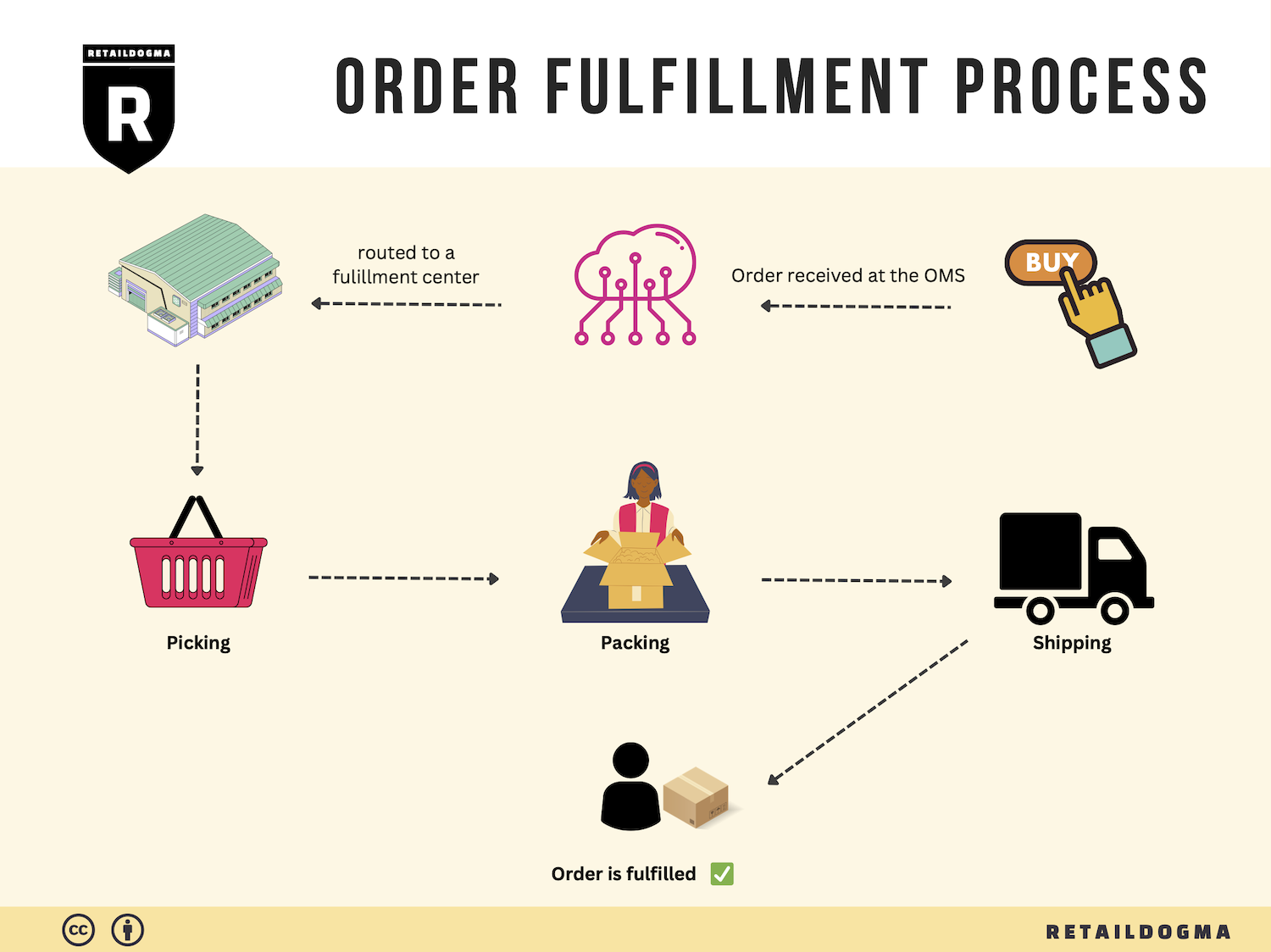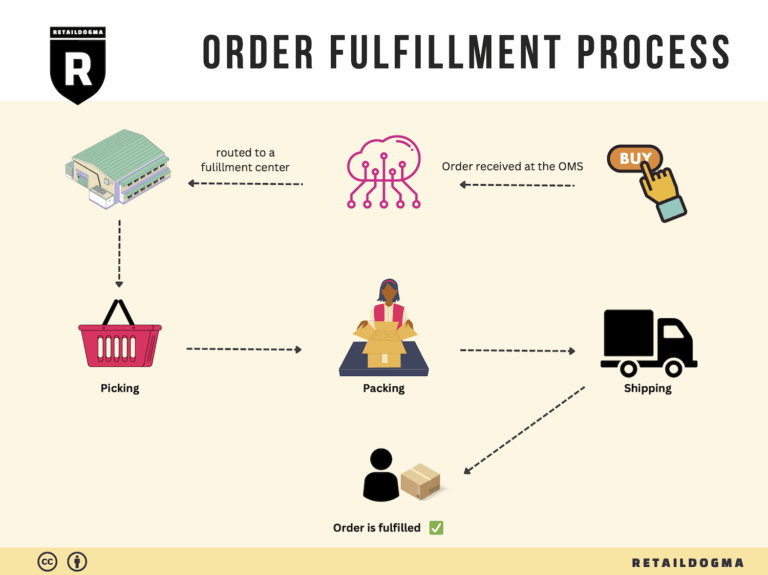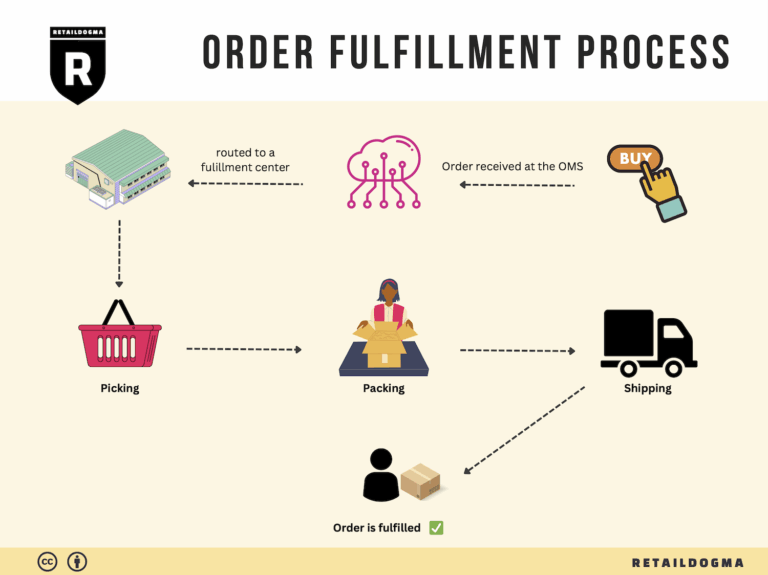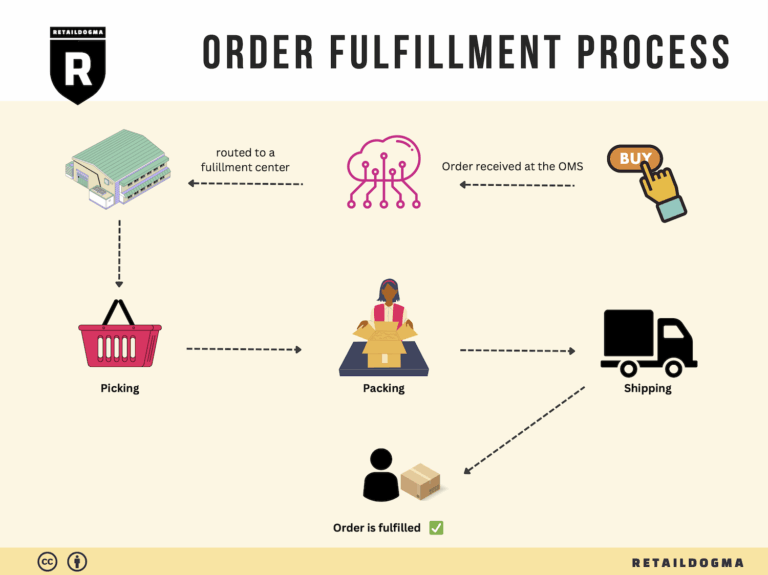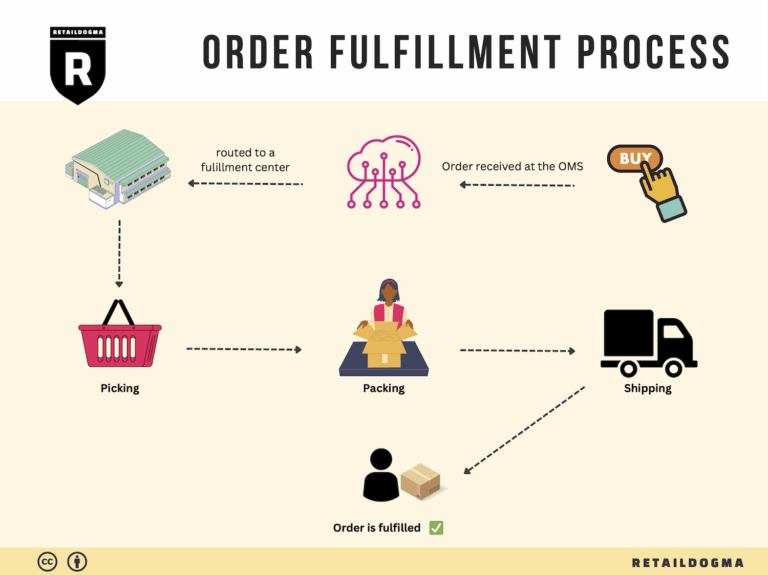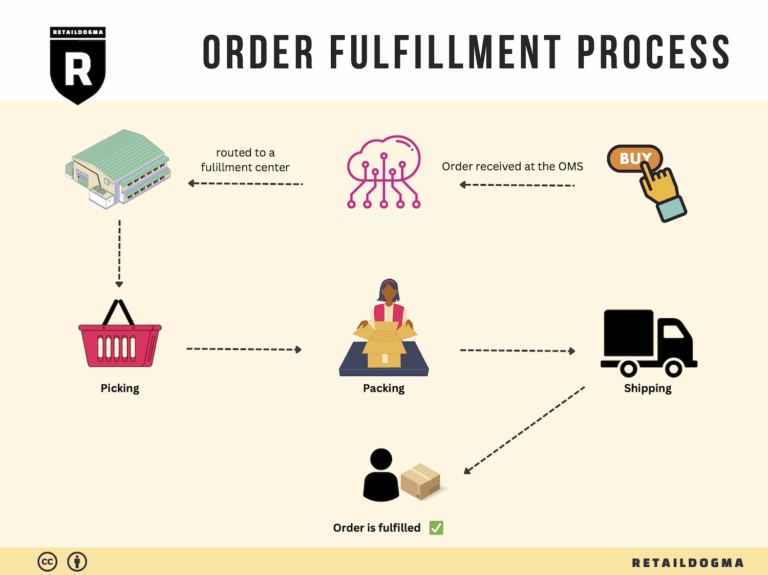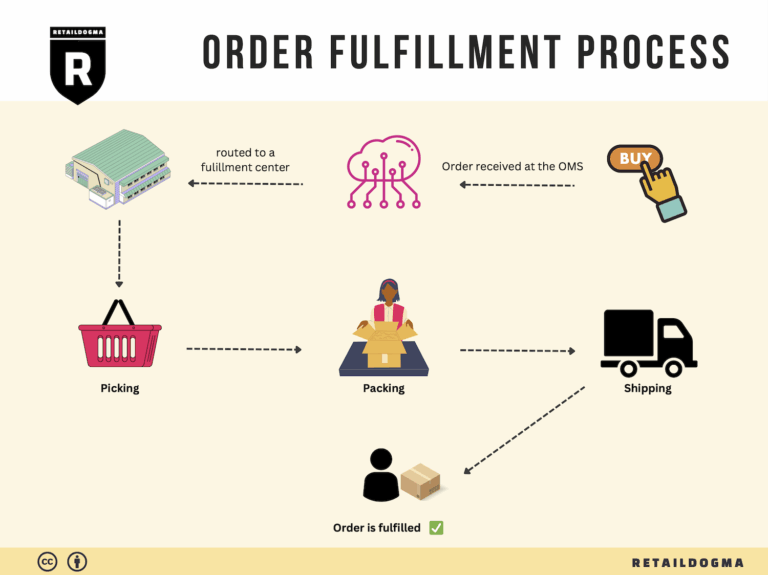Ecommerce Fulfillment Services: The Ultimate Guide (2025)
What is E-commerce Fulfillment? An Introduction for Growing Businesses
As an e-commerce business owner, you might find yourself drowning in the daily demands of packing and shipping orders. The excitement of growing sales can quickly turn into a logistical nightmare, leaving you overwhelmed and questioning whether you can keep up with customer expectations. This is where e-commerce fulfillment comes into play—a crucial process that involves getting your products from your inventory to your customers’ doorsteps efficiently and effectively.
Understanding E-commerce Fulfillment
E-commerce fulfillment encompasses all the steps involved in processing an order, from receiving it to delivering the product to the customer. It’s about more than just shipping; it includes inventory management, order processing, packing, and returns handling. As your business scales, the complexity of these operations increases, making it essential to have a streamlined fulfillment strategy.
Models of Fulfillment
In this guide, we will explore various fulfillment models that can help you streamline your operations. Two popular options are Third-Party Logistics (3PL) and Fulfilled by Amazon (FBA). 3PL providers handle warehousing, order processing, and shipping, allowing you to focus on growing your brand. FBA, on the other hand, leverages Amazon’s vast logistics network, giving you access to their resources and customer base while simplifying your shipping process.
Core Services
We will delve into the core services offered by fulfillment partners, including warehousing, inventory management, order processing, shipping, and returns management. Understanding these services will help you identify what you need to effectively serve your customers and scale your business.
Choosing the Right Partner
Selecting the right fulfillment partner is a pivotal decision for your business. This guide will provide insights on how to evaluate potential partners, what questions to ask, and what factors to consider to ensure a good fit for your operational needs.
Pricing Considerations
Finally, we will break down the pricing structures associated with different fulfillment options. Understanding these costs will empower you to make informed financial decisions that align with your business goals.
Empowering Your Business
Ultimately, this guide aims to empower e-commerce businesses to make smart logistics decisions. By understanding the nuances of fulfillment, you can enhance customer satisfaction, reduce operational headaches, and focus on what you do best—growing your brand and delighting your customers.
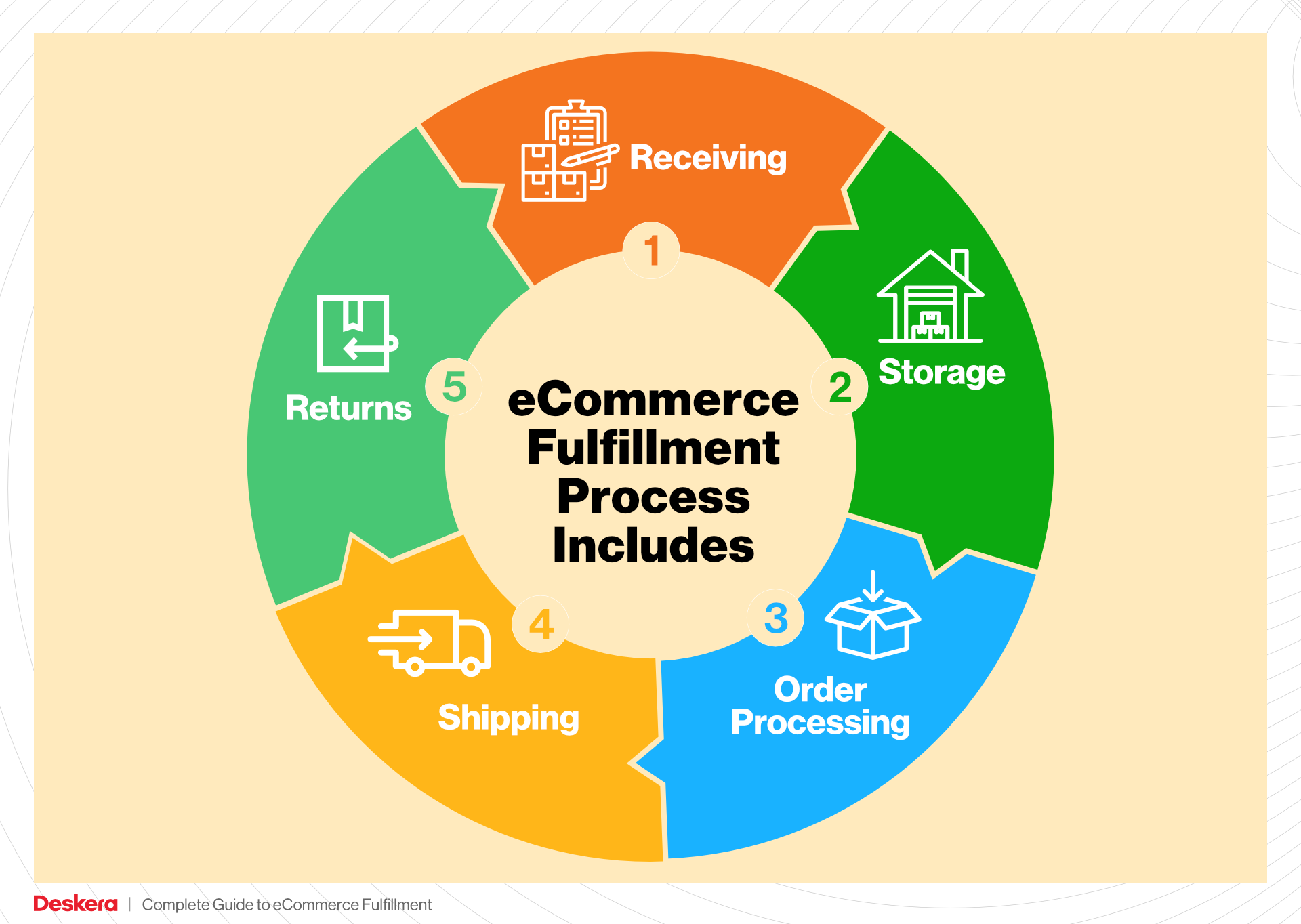
What You’ll Learn In This Guide
- What is E-commerce Fulfillment? An Introduction for Growing Businesses
- The Order Fulfillment Process: From ‘Buy’ Button to Customer’s Door
- Comparing Fulfillment Models: In-House vs. 3PL vs. Dropshipping
- A Deep Dive into Amazon FBA: Pros, Cons, and Who It’s For
- Core Services Offered by Fulfillment Centers
- How to Choose a Fulfillment Partner: A 6-Point Checklist
- Understanding Fulfillment Pricing: A Breakdown of Common Fees
- Frequently Asked Questions (FAQs) about Fulfillment
- Conclusion: Is Outsourcing Fulfillment the Right Move for Your Business?
- Important Disclaimer
The Order Fulfillment Process: From ‘Buy’ Button to Customer’s Door
1. Receiving Inventory
The first step in the order fulfillment process is the receiving of inventory. This is where products from suppliers or manufacturers are delivered to the fulfillment center. Upon arrival, the items are carefully unloaded and checked against the purchase orders to ensure accuracy. This process involves the use of Stock Keeping Units (SKUs) to identify each product uniquely.
Importance: Accurate receiving is crucial as it sets the foundation for the entire fulfillment process. Any discrepancies at this stage—such as missing items or incorrect quantities—can lead to issues down the line, including delayed shipments and dissatisfied customers.
Key Term: SKU (Stock Keeping Unit) – A unique identifier for each product, enabling efficient tracking and management of inventory.
2. Warehouse Storage
Once the inventory has been received and verified, the next step is warehouse storage. The products are organized and stored in designated locations within the fulfillment center. Effective warehouse management systems (WMS) play a vital role in this stage, as they help streamline the process of locating and retrieving items when orders come in.
Importance: Proper storage is essential for maximizing space and ensuring that items are easily accessible. A well-organized warehouse can significantly reduce the time it takes to pick orders, which is critical for maintaining fast delivery times.
Key Term: WMS (Warehouse Management System) – A software solution that helps manage inventory, track product locations, and optimize warehouse operations.
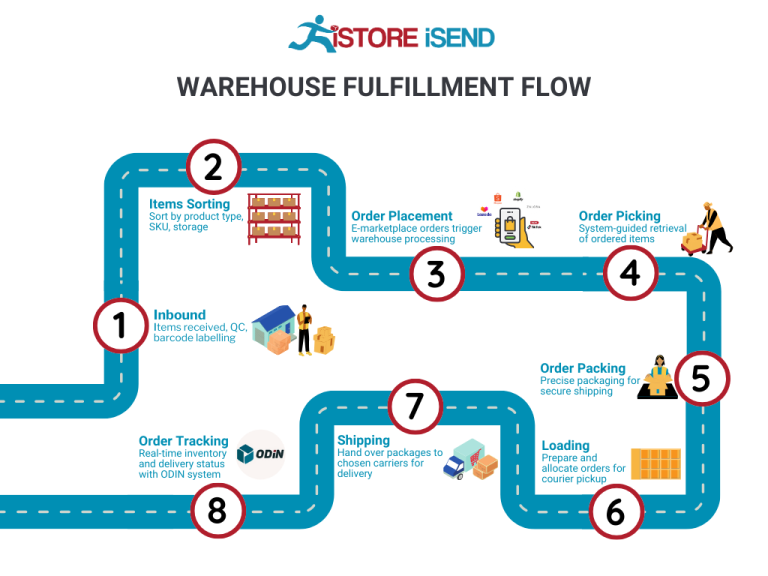
3. Order Picking
The third step is order picking, where items are retrieved from storage based on customer orders. Pick lists are generated, detailing the specific items and quantities needed for each order. Warehouse staff or automated systems then navigate the storage area to collect the products.
Importance: Efficient order picking is crucial for meeting customer expectations. A slow or inaccurate picking process can lead to delays and errors, ultimately affecting customer satisfaction and increasing operational costs.
Key Term: Pick List – A document or digital list that outlines the items to be collected for fulfilling a specific order, often organized by storage location to streamline the picking process.
4. Order Packing
After items have been picked, they move to the order packing stage. Here, products are carefully packaged for shipment. This involves selecting appropriate packing materials and boxes to ensure that items arrive at the customer’s door in perfect condition. Additionally, packing slips and shipping labels are generated and included with the order.
Importance: Proper packing is essential to prevent damage during transit and to enhance the overall customer experience. Effective packing processes can also reduce shipping costs by minimizing the size and weight of packages.
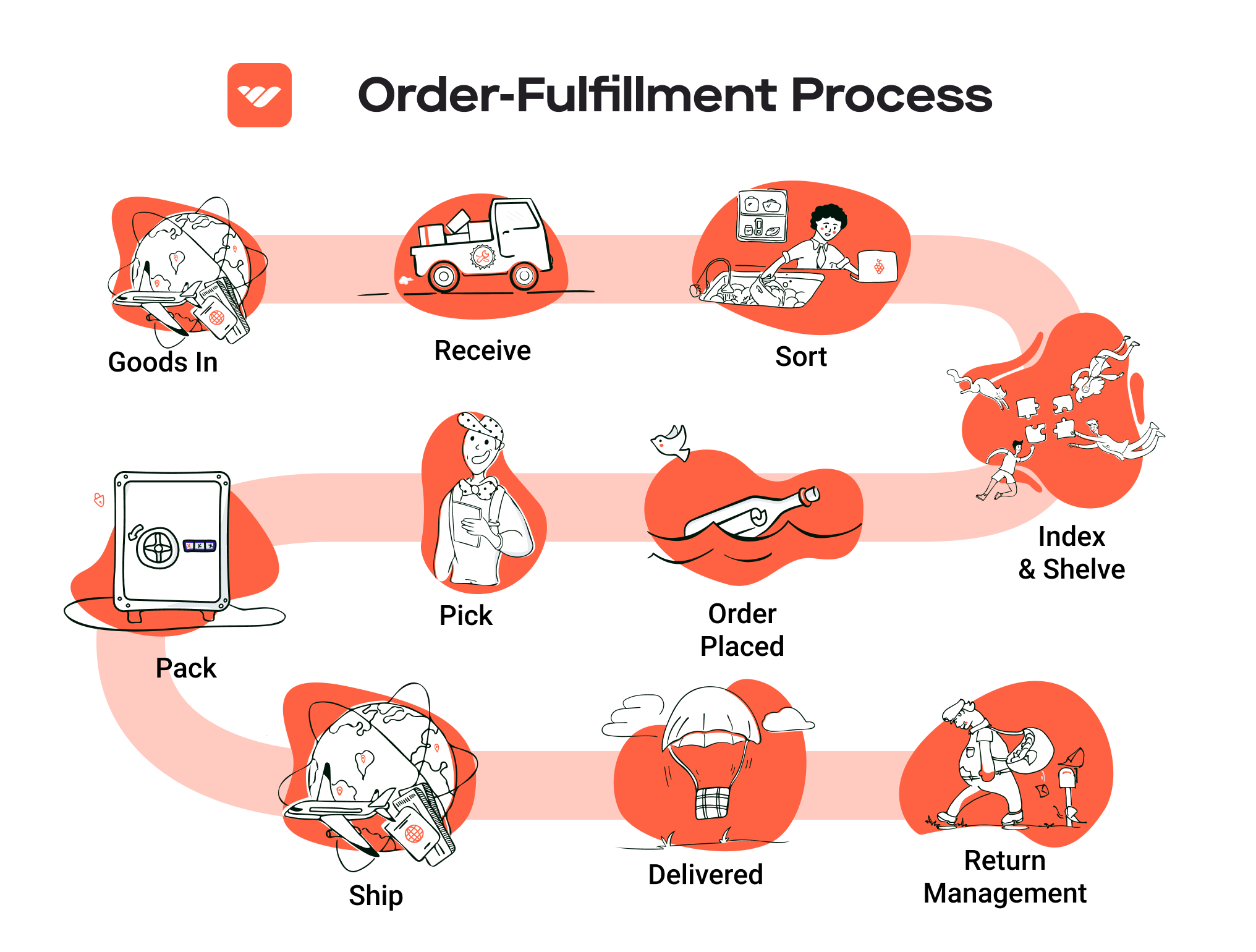
Key Term: Packing Slip – A document included in the shipment that lists the contents of the package, serving as a receipt for the customer and a checklist for the fulfillment team.
5. Shipping & Delivery
The final step in the order fulfillment process is shipping and delivery. Once packages are packed, they are labeled and handed over to shipping carriers for delivery to the customer. This step requires coordination with various shipping services to optimize delivery times and costs.
Importance: Timely shipping is critical for customer satisfaction. With the rise of e-commerce, customers expect fast and reliable delivery. Effective management of shipping logistics can also lead to reduced shipping costs and improved operational efficiency.
Key Term: Carrier – A company responsible for transporting packages from the fulfillment center to the customer’s address, which can include postal services, courier companies, or freight services.
In conclusion, understanding and optimizing each step of the order fulfillment process is vital for e-commerce businesses aiming to scale their operations. By focusing on accuracy in receiving, efficient storage, effective picking, careful packing, and reliable shipping, businesses can enhance their operational efficiency and improve customer satisfaction.
Comparing Fulfillment Models: In-House vs. 3PL vs. Dropshipping
Fulfillment Model Comparison
| Model | Who Handles Inventory | Best For (Business Stage) | Key Advantage | Key Disadvantage |
|---|---|---|---|---|
| In-House Fulfillment | The Business Itself | Startups to Established Businesses | Complete Control Over Operations | High Initial Costs and Overhead |
| Third-Party Logistics (3PL) | Third-Party Provider | Growing to Established Businesses | Scalability and Expertise | Less Control Over Inventory Management |
| Dropshipping | Supplier/Vendor | Startups and Small Businesses | Low Startup Costs and No Inventory Risk | Lower Margins and Less Control Over Fulfillment |
In-House Fulfillment
In-house fulfillment involves managing the entire logistics process within your own organization. This model is typically adopted by businesses that have the resources and infrastructure to handle storage, packing, and shipping. In-house fulfillment provides complete control over inventory management, order processing, and quality assurance. Businesses can tailor their fulfillment process to meet specific customer needs and preferences, allowing for a more personalized customer experience. However, this model also comes with significant challenges. It requires substantial upfront investment in warehouse space, staffing, and technology. As a business scales, the complexities of managing logistics can increase, leading to operational inefficiencies and potential service disruptions if not managed effectively. This model is best suited for businesses with stable demand and a strong operational foundation, allowing them to maintain control without sacrificing efficiency.
Third-Party Logistics (3PL)
Third-party logistics (3PL) providers offer a comprehensive solution for businesses looking to outsource their fulfillment operations. In this model, a third-party vendor handles inventory management, warehousing, packing, and shipping. This approach is particularly beneficial for growing businesses that want to focus on their core competencies—such as product development, marketing, and sales—while leveraging the expertise and resources of a logistics provider. 3PLs can scale operations quickly to accommodate fluctuations in demand, making them ideal for seasonal businesses or those experiencing rapid growth. Additionally, 3PLs often have established relationships with shipping carriers, which can result in reduced shipping costs and improved delivery times. However, outsourcing fulfillment means relinquishing some control over inventory management and order processing. Businesses must ensure that their 3PL partner aligns with their service standards and can effectively manage their brand’s reputation. This model works best for companies looking to grow without the burden of managing logistics directly.
Dropshipping
Dropshipping is a fulfillment model where the retailer does not hold inventory but instead partners with suppliers who ship products directly to customers on behalf of the retailer. This model is especially appealing to startups and small businesses, as it requires minimal upfront investment and eliminates the risks associated with unsold inventory. Retailers can offer a wide range of products without the need for warehousing, making it easier to test new markets and product lines. Additionally, dropshipping allows for flexibility in scaling operations since retailers can quickly add or remove products based on demand without significant financial implications. However, dropshipping also comes with notable challenges. Profit margins can be lower than traditional fulfillment models, as suppliers often charge higher prices for their services. Furthermore, retailers have less control over the shipping process, which can lead to inconsistent delivery times and potential customer dissatisfaction. This model is best suited for entrepreneurs willing to navigate the complexities of supplier relationships and customer service challenges while prioritizing low overhead costs.
Conclusion
Choosing the right fulfillment model is a critical decision for e-commerce businesses looking to scale. Each model—whether in-house, 3PL, or dropshipping—offers unique advantages and disadvantages that can significantly impact operational efficiency, customer satisfaction, and overall business growth. Understanding the nuances of each model allows business owners to make informed decisions that align with their long-term objectives and current operational capabilities. As businesses evolve, they may find it beneficial to reassess their fulfillment strategy to better meet changing market demands and customer expectations.
A Deep Dive into Amazon FBA: Pros, Cons, and Who It’s For
Understanding Fulfillment by Amazon (FBA)
Fulfillment by Amazon (FBA) is a service provided by Amazon that allows sellers to store their products in Amazon’s fulfillment centers. When a customer orders a product, Amazon takes care of storage, packaging, shipping, and customer service on behalf of the seller. This model simplifies logistics for e-commerce businesses, enabling them to focus on sales and marketing rather than operations.
How FBA Works
-
Setup: Sellers create an Amazon seller account and list their products on Amazon. They must then enroll in the FBA program and send their inventory to Amazon’s fulfillment centers.
-
Storage: Amazon stores the products in their warehouses. Sellers can track their inventory levels through the Amazon Seller Central dashboard.
-
Order Processing: When a customer places an order, Amazon picks, packs, and ships the product. This process is efficient and typically quick, often leading to faster delivery times.
-
Customer Service: Amazon handles all customer inquiries and returns related to the FBA products, providing a seamless experience for both sellers and customers.
-
Fees: Sellers pay fees based on storage space and fulfillment costs. These fees can vary depending on the time of year, size, and weight of the products.
Pros of Using FBA
-
Prime Eligibility: Products fulfilled by Amazon are eligible for Amazon Prime, which can significantly increase visibility and sales. Prime members often prefer Prime-eligible items due to the benefits of free two-day shipping.
-
Customer Trust: By leveraging Amazon’s reputation, sellers can benefit from customer trust. Shoppers are more likely to purchase products fulfilled by Amazon because of the assurance of reliable service and easy returns.
-
Multi-Channel Fulfillment: FBA allows sellers to fulfill orders from other sales channels (like their own websites) using Amazon’s fulfillment centers. This means sellers can streamline their logistics and manage inventory in one place.
-
Scalability: FBA provides an opportunity for businesses to scale quickly without needing to invest heavily in their own warehousing and logistics infrastructure. Sellers can increase their product offerings without worrying about storage space.
-
Time Savings: Automating the fulfillment process means sellers can focus on growing their business rather than managing logistics, which can be time-consuming and complex.
Cons of Using FBA
-
High Fees: FBA fees can add up quickly, including storage fees, fulfillment fees, and additional costs for long-term storage. These expenses can significantly eat into profit margins, especially for low-cost items.
-
Strict Inventory Rules: Amazon has specific guidelines regarding inventory management, including how products must be packaged and labeled. Non-compliance can lead to extra fees or even removal from the FBA program.
-
Commingling Risks: With commingled inventory, products from multiple sellers are stored together. This can lead to issues if a customer receives a product from another seller instead of the original seller’s item, potentially harming brand reputation.
-
Limited Control: By outsourcing fulfillment to Amazon, sellers give up some control over the customer experience. For example, they cannot customize packaging or handle customer service directly.
-
Competition: FBA sellers are often competing with other FBA sellers for the same buy box. This can lead to price wars and reduced profitability.
Who is FBA Best For?
FBA is particularly beneficial for:
-
Small to Medium-Sized Businesses: Those looking to scale quickly without the overhead costs associated with warehousing and logistics can leverage FBA to grow their operations.
-
E-commerce Entrepreneurs: New sellers entering the marketplace can benefit from Amazon’s vast customer base and trusted infrastructure, helping them gain traction faster.
-
Seasonal Sellers: Businesses that experience peak seasons can utilize FBA for temporary inventory storage and fulfillment without committing to long-term warehousing solutions.
-
Brands Seeking Credibility: Companies that are looking to establish their brand on Amazon and gain customer trust will find FBA advantageous due to Amazon’s reputation and customer service.
-
Multi-Channel Sellers: Those who sell on multiple platforms and want a streamlined fulfillment process can take advantage of Amazon’s multi-channel fulfillment capabilities.
In conclusion, FBA offers a powerful solution for e-commerce businesses looking to simplify their logistics and enhance their market reach. While there are costs and risks involved, the benefits can outweigh these concerns for many sellers, particularly those who are strategic about their inventory management and pricing. Understanding both the advantages and limitations of FBA is crucial for businesses considering this fulfillment model to ensure it aligns with their growth objectives.
Core Services Offered by Fulfillment Centers
Inventory Management & Warehousing
Inventory management and warehousing are foundational services provided by fulfillment centers, crucial for e-commerce businesses looking to optimize their operations. This service involves the systematic tracking of inventory levels, orders, sales, and deliveries. Fulfillment centers utilize advanced inventory management software to provide real-time visibility into stock levels, which helps businesses avoid stockouts or overstock situations.
The benefits of efficient inventory management are multifaceted. For one, it enhances order accuracy and reduces the risk of errors, which can lead to customer dissatisfaction. Additionally, effective inventory management allows businesses to forecast demand more accurately, enabling them to adjust their stock levels accordingly. This not only minimizes holding costs but also ensures that businesses can meet customer demands promptly, improving overall customer satisfaction and loyalty. Furthermore, by leveraging warehousing solutions, e-commerce businesses can store products closer to their customers, resulting in faster shipping times and reduced shipping costs.
Pick and Pack Services
Pick and pack services are integral to the order fulfillment process, where fulfillment centers handle the selection and packing of products for shipment. Once an order is placed, the fulfillment center’s staff picks the items from the warehouse shelves, packs them securely, and prepares them for shipment. This process is often streamlined through the use of automated systems and technology, which enhance efficiency and accuracy.
The primary benefit of pick and pack services is the significant reduction in time and labor costs for e-commerce businesses. By outsourcing this function, businesses can focus their resources on core activities such as marketing and product development instead of managing order fulfillment logistics. Moreover, professional fulfillment centers often employ best practices in packaging, which can improve the presentation of products and enhance the unboxing experience for customers. This attention to detail can lead to increased customer satisfaction and potentially more repeat business.
Kitting and Assembly
Kitting and assembly services offered by fulfillment centers involve the grouping of individual items into ready-to-sell sets or kits. This process can include anything from assembling furniture pieces to creating gift sets or promotional bundles. Fulfillment centers efficiently manage the labor and logistics required for kitting, ensuring that products are prepared for sale in a timely manner.
The benefits of kitting and assembly services are particularly pronounced for businesses looking to offer unique product combinations or promotional items. By providing a streamlined process for assembling these kits, fulfillment centers can help businesses reduce labor costs and improve production timelines. Additionally, kitting can enhance the perceived value of products, making them more appealing to customers. By presenting products in curated sets, businesses can also encourage higher average order values, as customers are often willing to purchase more when presented with attractive bundles.
Returns Management (Reverse Logistics)
Returns management, also known as reverse logistics, is a critical service provided by fulfillment centers, especially for e-commerce businesses where return rates can be higher than traditional retail. This service encompasses the entire process of handling returned products, from receiving and inspecting returned items to restocking or disposing of them as needed.
The effective management of returns can significantly impact a business’s bottom line. A well-organized returns process enhances customer satisfaction by making returns easy and hassle-free, which can lead to increased trust and loyalty. Additionally, fulfillment centers often employ technology to track return reasons, which can provide valuable insights into product quality and customer preferences. Understanding why items are returned allows businesses to make informed decisions about product improvements and inventory management, ultimately reducing future return rates. Moreover, by efficiently processing returns, fulfillment centers can minimize the financial impact on businesses, turning potential losses into opportunities for customer retention and satisfaction.
In summary, the core services offered by fulfillment centers—inventory management and warehousing, pick and pack services, kitting and assembly, and returns management—are essential for e-commerce businesses aiming to scale operations. By leveraging these services, businesses can enhance their operational efficiency, improve customer satisfaction, and ultimately drive sales growth.
How to Choose a Fulfillment Partner: A 6-Point Checklist
Location & Warehouse Network
Importance:
The location of your fulfillment partner’s warehouses significantly impacts shipping costs, delivery times, and overall customer satisfaction. A strategically located warehouse network allows for quicker delivery to your customer base, which is crucial for maintaining competitive advantage in the e-commerce space.
Questions to Ask:
– Where are your warehouses located, and how many do you operate?
– How do you determine which warehouse will fulfill a specific order?
– Do you have plans for expanding your warehouse network in the near future?
– What shipping carriers do you partner with, and what are their delivery times?
Technology & Integrations
Importance:
The technology used by your fulfillment partner can streamline operations, enhance visibility, and improve order accuracy. An efficient order management system (OMS) that integrates with your e-commerce platform is essential for real-time inventory updates and order tracking.
Questions to Ask:
– What technology platforms do you use for inventory management and order processing?
– Can your system integrate with our existing e-commerce platforms (e.g., Shopify, WooCommerce, Amazon)?
– How do you handle inventory tracking and reporting?
– Do you provide real-time visibility into order status and inventory levels?
Specializations (e.g., cold storage, oversized items)
Importance:
Different businesses have unique product requirements. If you sell specialized items, such as perishable goods or oversized products, ensure that your fulfillment partner has the necessary capabilities and experience to handle these items safely and efficiently.
Questions to Ask:
– Do you have specialized storage options (e.g., climate-controlled environments, heavy-duty shelving)?
– What experience do you have in handling my specific type of product?
– How do you ensure compliance with safety and quality regulations for specialized products?
– Can you provide case studies or references from clients with similar product needs?
Scalability & Capacity
Importance:
As your business grows, your fulfillment needs will likely change. Your partner should be able to scale operations to match your growth, whether that’s during peak seasons or as you expand your product line.
Questions to Ask:
– What is your current capacity, and how do you handle increases in order volume?
– Have you worked with businesses that have experienced rapid growth? If so, how did you support them?
– What contingency plans do you have in place for unexpected surges in demand?
– Can you provide a timeline for ramping up operations if needed?
Pricing and Contracts
Importance:
Understanding the pricing structure and contract terms is crucial to avoid unexpected costs that can eat into your margins. A transparent pricing model will help you budget effectively and assess the total cost of fulfillment.
Questions to Ask:
– What are your pricing models (e.g., per order, per item, monthly fees)?
– Are there any additional fees for services like storage, returns, or special handling?
– Can you provide a detailed breakdown of all potential costs?
– What are the terms for contract renewal or termination, and is there flexibility to adjust the agreement as needed?
Customer Support & Reviews
Importance:
Reliable customer support is essential for resolving issues promptly and maintaining a smooth operation. Additionally, reviews and testimonials can provide insights into a partner’s reputation and reliability.
Questions to Ask:
– What customer support options do you offer (e.g., phone, email, live chat)?
– What are your typical response times for customer inquiries or issues?
– Can you provide references or case studies from current clients?
– How do you handle errors or issues in order fulfillment, and what is your process for rectifying them?
Conclusion
Choosing the right fulfillment partner is a critical decision that can affect your e-commerce business’s efficiency, customer satisfaction, and ultimately, your bottom line. By carefully evaluating potential partners against this checklist, you can make an informed choice that aligns with your business goals and operational needs. Take the time to ask the right questions, and don’t hesitate to seek references and case studies to ensure you select a partner that can support your growth and success in the competitive online marketplace.
Understanding Fulfillment Pricing: A Breakdown of Common Fees
Initial Setup Fees
When partnering with a fulfillment center, the initial setup fees are often the first cost you will encounter. These fees can vary significantly based on the provider and the complexity of your inventory. Typically, initial setup fees cover the costs of establishing your account, integrating your systems, and preparing your inventory for storage.
Calculation: Initial setup fees may be a flat rate or based on the number of SKUs you have. Some fulfillment centers may charge additional fees for software integration or special handling of your products. Expect to pay anywhere from $50 to several hundred dollars, depending on the level of service and complexity.
Receiving Fees
Receiving fees are charged when your products arrive at the fulfillment center. These fees cover the labor and resources required to unload, inspect, and store your inventory.
Calculation: Generally calculated on a per-pallet or per-carton basis, receiving fees can vary based on the volume of items being received. For instance, if you send in a large shipment of products, the cost may be calculated per pallet, while smaller shipments may incur a fee per carton. On average, receiving fees can range from $5 to $15 per pallet or carton.
Storage Fees (per pallet/bin)
Once your products are stored in the fulfillment center, you will incur storage fees. These fees are charged for the space your inventory occupies and are typically assessed monthly.
Calculation: Storage fees are commonly charged per pallet or per bin, depending on how your items are stored. For example, if you have a pallet of goods occupying space, you might be charged a monthly fee based on the size and quantity of pallets. Rates can range from $10 to $30 per pallet per month, with some centers offering tiered pricing based on volume.
Pick & Pack Fees (per item/order)
Pick and pack fees are incurred each time an order is processed. This includes the cost of picking items from storage and packing them for shipment. This fee is particularly important for businesses that experience high order volume.
Calculation: These fees are usually calculated on a per-item or per-order basis. For example, if you have multiple items in one order, the fee may be charged per item picked and packed. Typical rates can range from $1 to $3 per item, with discounts available for larger orders.
Shipping Fees
Shipping fees are one of the most significant costs associated with fulfillment. They cover the transportation of your products from the fulfillment center to your customers.
Calculation: Shipping fees depend on several factors including the weight and dimensions of the package, the shipping method (standard, expedited, etc.), and the delivery destination. Many fulfillment centers use tiered pricing models based on weight classes or zones, so the cost can vary significantly. Businesses can expect to pay anywhere from $5 to $20 for domestic shipping, with international rates being higher.
Tips for Getting an Accurate Quote
-
Provide Detailed Information: When requesting a quote, provide as much information as possible about your inventory, order volume, and shipping needs. This will help fulfillment centers give you a more accurate estimate.
-
Ask About Hidden Fees: Inquire about any potential hidden fees that may apply, such as returns processing fees, long-term storage fees, or seasonal surcharges.
-
Consider Your Growth: Make sure the quote reflects not just your current needs, but also your projected growth. Some fulfillment centers offer scalable solutions that can adapt to your business’s changing demands.
-
Negotiate Terms: Don’t hesitate to negotiate terms or ask for discounts based on volume. Many fulfillment centers are open to providing better rates for businesses that can guarantee higher order volumes.
-
Get Multiple Quotes: Finally, it’s advisable to get quotes from multiple fulfillment centers. This will give you a better understanding of the market rates and help you choose a provider that offers the best value for your specific needs.
By understanding these common fees and how they are calculated, you can make informed decisions when selecting a fulfillment partner that aligns with your e-commerce business goals.
Frequently Asked Questions (FAQs) about Fulfillment
1. What is an Amazon fulfillment center number?
An Amazon fulfillment center number is a unique identifier assigned to each fulfillment center operated by Amazon. This number is used to track inventory, manage shipments, and facilitate the logistics of order fulfillment through Amazon’s vast network of warehouses.
2. How do I find my Amazon fulfillment center number?
You can find your Amazon fulfillment center number by logging into your Seller Central account. Navigate to the ‘Inventory’ tab, select ‘Manage Inventory,’ and look for the fulfillment center information associated with your products. Additionally, Amazon provides this information in shipment creation and order management sections.
3. What’s the difference between a warehouse and a fulfillment center?
A warehouse primarily serves as a storage space for goods, focusing on inventory management. In contrast, a fulfillment center is designed to process orders and ship products directly to customers. Fulfillment centers often include additional services like packing, labeling, and returns management, making them integral to e-commerce operations.
4. What is a 3PL (Third-Party Logistics)?
A 3PL is a service provider that manages logistics and supply chain functions on behalf of another company. This includes warehousing, inventory management, order fulfillment, and shipping. Utilizing a 3PL allows businesses to focus on their core competencies while outsourcing logistics to experts.
5. How much do fulfillment services cost?
Fulfillment service costs vary widely based on factors such as the type of products, order volume, and specific services required. Typical costs may include storage fees, pick-and-pack fees, shipping fees, and additional charges for special handling. Businesses should obtain quotes from multiple fulfillment providers to find the best fit for their budget and needs.
6. How does Amazon’s fulfillment process work?
Amazon’s fulfillment process involves several steps: receiving inventory at a fulfillment center, storing products, processing customer orders, picking items from storage, packing them for shipment, and finally shipping them to the customer. This streamlined process allows for quick delivery and efficient inventory management.
7. Can I use multiple Amazon fulfillment centers?
Yes, businesses can utilize multiple Amazon fulfillment centers to enhance their distribution capabilities. By distributing inventory across various centers, sellers can improve shipping times and reduce transportation costs, ultimately leading to better customer satisfaction.
8. What are the benefits of using Amazon fulfillment centers?
Using Amazon fulfillment centers offers several advantages, including access to Amazon’s extensive logistics network, faster shipping options (like Prime), reduced operational costs, and the ability to scale operations without the need for significant infrastructure investments. Additionally, it allows sellers to leverage Amazon’s customer service and returns management.
9. How do I manage inventory across multiple fulfillment centers?
To manage inventory across multiple fulfillment centers effectively, sellers can utilize Amazon’s inventory management tools within Seller Central. This includes tracking stock levels, setting reorder alerts, and using reports to analyze inventory performance. Integration with third-party inventory management systems can also enhance visibility and control.
10. What should I consider when choosing a fulfillment service provider?
When selecting a fulfillment service provider, consider factors such as the provider’s experience, technology capabilities, pricing structure, shipping options, and customer service. Additionally, assess their ability to scale with your business, handle specific product requirements, and manage returns efficiently. Conducting thorough due diligence and seeking references can help ensure a good partnership.
Conclusion: Is Outsourcing Fulfillment the Right Move for Your Business?
Assessing the Benefits of Outsourcing Fulfillment
Outsourcing your fulfillment can be a game-changer for your e-commerce business. By partnering with a fulfillment service, you can unlock a multitude of benefits that directly contribute to your operational efficiency and overall growth.
First and foremost, outsourcing fulfillment saves you valuable time. Managing inventory, packing orders, and handling shipping logistics can be overwhelming, especially as your sales volume increases. By leveraging a fulfillment service, you can redirect your focus toward core business activities such as product development, marketing, and customer engagement. This shift not only enhances productivity but also allows you to respond swiftly to market demands.
Scalability is another significant advantage. As your business grows, so do your fulfillment needs. A reputable fulfillment partner provides the flexibility to scale operations seamlessly, accommodating seasonal spikes in demand or new product launches without the headache of managing additional resources. This adaptability is crucial for maintaining service quality and customer satisfaction.
Moreover, fulfillment services bring expertise that can enhance your logistics strategy. They have established processes, advanced technology, and industry insights that can optimize shipping times and reduce costs. Their experience in navigating complex logistics challenges means fewer errors and improved service levels, ultimately benefiting your bottom line.
Choosing the Right Partner
However, the success of outsourcing fulfillment hinges on selecting the right partner. Conduct thorough research, assess potential partners’ capabilities, and ensure they align with your business goals. A good partner will not only meet your current needs but also support your growth trajectory.
Call to Action
Now is the time to evaluate your current shipping and fulfillment processes. Conduct an audit to identify bottlenecks, inefficiencies, and areas for improvement. Ask yourself: Could a fulfillment partner provide the expertise and scalability my business needs to thrive? Taking this proactive step could be the key to unlocking your e-commerce potential.
Important Disclaimer
⚠️ Important Disclaimer
The information in this guide is for educational purposes. Fulfillment services, pricing, and platform features change frequently. Always conduct your own due diligence and consult with providers directly before making business decisions.
